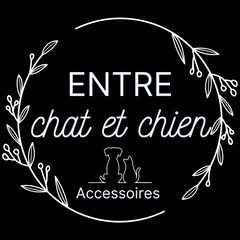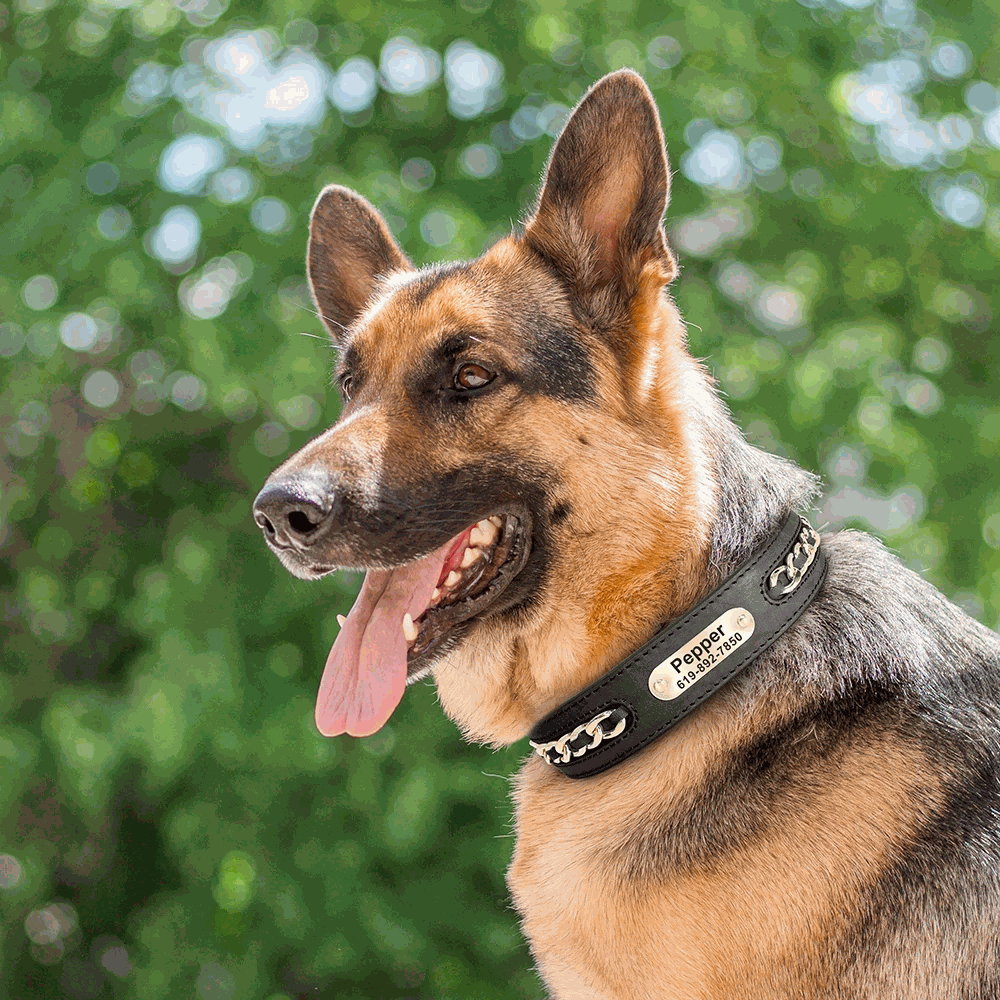Complete Guide: The Perfect Collar for Your Dog or Cat in 5 Steps
Did you know that 75% of owners make this fatal mistake when choosing their pet's collar? If you want to avoid these pitfalls and ensure your pet's comfort and safety, this guide is for you.
⚡ Flash Section: What You Will Learn
🎯 Main Objective: Choose a collar perfectly suited to the needs and comfort of your dog or cat, while ensuring its safety.
⏱️ Time Required: 30 minutes of reading for immediate application.
📋 Prerequisites:
· Know your pet's weight and size.
· Observe your pet's behavior (calm, energetic, pulls on the leash, etc.).
🛠️ Materials Needed:
· A tape measure to measure your pet's neck.
· Personalized Leather Collar | Engraved ID Tag for Dogs - [ https://entrechatetchien.com/products/velvet-collar-for-dogs-free-engraving-for-medium-and-large-dogs )
· Luxury Collar for Dogs and Cats | Jewelry with Zircon Bone | Adjustable - [ https://entrechatetchien.com/products/collier-reglable-de-luxe-pour-chiens-et-chats-bijou-avec-os-en-zircon )
· Personalized Leather Collar | Engraved Dog Tag - [ https://entrechatetchien.com/products/personalized-leather-collar-engraved-dog-tag )
✅ Expected Results:
· A comfortable and safe pet with its new collar.
· Reduced risk of escape or injury.
· A durable necklace suitable for everyday use.
🚀 Step 1: Understand Your Pet's Specific Needs
⏱️ Duration: 5 minutes 🎯 Objective: Identify the type of collar best suited to the size, breed and temperament of your dog or cat.
📋 Concrete Actions:
1. Assess your pet's size and weight : A Chihuahua will not have the same needs as a Labrador. The size of the collar should be proportional to the animal. For cats, choose lightweight collars with a safety system.
2. Consider your pet's temperament : Is he calm, very active, or does he pull on the leash? A dog that pulls will need a sturdier collar or harness. An adventurous cat will require a collar with a safety clasp that opens in case of snagging.
3. Consider the primary use : Is it a collar for identification, daily walking, training, or simply an aesthetic accessory?
💡 Pro Tip: For larger dogs or those that tend to pull, consider a wider collar for better pressure distribution across the neck, or a harness to relieve the strain on the trachea.
⚠️ Mistake to Avoid: Choosing a collar that is too loose (risk of escape) or too tight (risk of strangulation or irritation). You should be able to fit two fingers between the collar and your pet's neck.
✅ How to Know It's Successful: Your pet is comfortable, doesn't scratch its neck excessively, and the collar stays in place without slipping.
🎯 Step 2: Choose the Material and Style of the Necklace
⏱️ Duration: 10 minutes 🎯 Objective: Select a durable and comfortable material, and a style that matches the desired aesthetic.
📋 Concrete Actions:
4. Explore the materials :
· Leather (e.g., Custom Leather Collar): Durable, stylish, and becomes more supple over time. Ideal for everyday use and for owners who appreciate a classic look. Offers great durability for medium to large dogs.
· Velvet (e.g., velvet dog collar): Soft, comfortable, often with customization options and a more upscale look. Perfect for pets with sensitive skin or for special occasions. Less water-resistant than leather.
· Nylon/Fabric : Lightweight, affordable, water-resistant, and available in a variety of colors and patterns. Very practical for walks or water activities. Some people find it less attractive than leather or velvet.
· Metal/Chain : Generally reserved for training or specific uses, less comfortable for everyday use.
5. Consider style and functionality : Simple collar, with a buckle, with an ID tag, with embellishments (e.g., Luxury Zircon Bone Collar). Think aesthetics as well as practicality. A personalized collar with your name and phone number is a major security asset.
💡 Pro Tip: Genuine leather ages beautifully and develops a unique patina. For velvet collars, regular cleaning is recommended to maintain their appearance and softness.
⚠️ Mistake to Avoid: Prioritizing aesthetics over your pet's comfort and safety. A collar must, above all, be functional and fit well.
✅ How to Know It's Successful: The material is suitable for your pet's living environment (water resistance, warmth), and the style pleases you while being practical for your use.
🏆 Step 3: Correctly Measure Your Pet's Neck
⏱️ Duration: 5 minutes 🎯 Goal: To obtain an accurate measurement of your pet's neck to ensure a perfect fit.
📋 Concrete Actions:
6. Get a soft tape measure : If you don't have one, a string or a piece of fabric with a ruler will do.
7. Measure your pet's neck : Place the tape measure where the collar would naturally sit, just below the base of the skull. Make sure the tape measure is neither too loose nor too tight.
8. Apply the "two-finger rule" : Once you've measured, add about 2 centimeters (the equivalent of two fingers) for comfort. This is the ideal amount of space so the collar doesn't restrict breathing or rub against the skin, while still being snug enough to prevent your pet from escaping.
💡 Pro Tip: Measure your pet several times to confirm the size. For growing puppies and kittens, allow for extra room or opt for an adjustable collar so you don't have to replace it too quickly.
⚠️ Mistake to Avoid: Using a previous collar size without re-measuring, especially if your pet has grown or gained weight. Ignoring hair type (long-haired pets may need a little more leeway).
✅ How to Know It's Successful: The collar, once adjusted, allows two fingers to easily slide between the pet's neck and the collar, without being loose.
🔧 Troubleshooting Common Problems
❌ Problem #1: The collar irritates my pet's skin.
· Cause: Collar too tight, unsuitable material (allergy), or constant rubbing.
· Solution: Check the fit with a two-finger rule. Change the material (choose velvet or softer leather). Make sure the collar is clean and dry. Consider a harness if irritation persists.
· Prevention: Choose a good quality collar, suitable for the sensitivity of your pet's skin, and clean it regularly.
❌ Problem #2: My pet can remove its collar.
· Cause: Collar too loose, animal too small for the collar, or the collar is not adapted to its behavior (e.g.: cat that climbs).
· Solution: Tighten the collar if possible (following the two-finger rule). For cats, make sure the collar has a safety clasp. For dogs, check the sturdiness of the buckle. If your pet is a "Houdini," a harness may be a better option.
· Prevention: Measure carefully before purchasing and choose a sturdy, well-fitting model.
📈 Optimization: Level Up
🚀 Advanced Techniques:
· GPS Collars : For maximum security, especially if your pet tends to escape or get lost. Ideal for adventurous pets.
· Flea and tick collars : Additional protection, although topical or oral treatments are often more effective.
📊 Measure Your Progress: Observe your pet's behavior: Is he comfortable? Is he scratching less? Does the collar stay in place during daily activities?
🔄 Maintaining Results: Clean the collar regularly. Check the fit at least once a month, especially for young, growing animals. Replace the collar if it becomes damaged or worn.
💡 Our Expert Secrets
🎯 The Tip No One Knows: For long-haired dogs, opt for collars with smooth metal buckles and rings to avoid snagging and pulling hair. The personalized-leather-collar-with-engraved-ID-tag-for-dogs is excellent for this thanks to its smooth surface.
⏰ Perfect Timing: The best time to introduce a new collar is during a quiet time at home, associating the collar with positive experiences (treats, games, petting).
🎁 Technical Bonus: Always pair the collar with an engraved ID tag (like the one on the personalized-leather-collar ) with your phone number. This is the first line of defense if your pet gets lost.
📋 Checklist: Your Action Plan
Preparation Phase:
· [x] Measure my pet's neck.
· [x] Observe his temperament and activity level.
· [x] Define the primary use of the collar (walking, identification, style).
Execution Phase:
· [ ] Choose the material and style of the necklace.
· [ ] Check the safety features (clasp, strength).
· [ ] Buy the necklace taking into account the advice in the guide.
Monitoring Phase:
· [ ] Adjust the collar with the two-finger rule.
· [ ] Observe my pet's comfort and behavior.
· [ ] Clean the collar regularly.
🛡️ Precautions and Safety
⚠️ Contraindications: Never use prong or choke collars without the advice of a dog training professional. Never leave a safety collar on a cat unattended if it does not have a self-releasing clasp.
🏥 When to Consult a Professional: If your pet experiences persistent skin irritation, difficulty breathing, or stress-related behavior while wearing the collar, consult a veterinarian or animal behaviorist.
🎯 Summary: Key Points to Remember
🏆 The 3 Pillars of Success:
9. Accurate Measurement and Fit : Two fingers between the collar and neck for optimal comfort and security.
10. Suitable Material : Choose based on activity, comfort and desired durability (leather, velvet, nylon).
11. Safety and Identification : Choose a collar with an identification tag and an appropriate security system for your pet.
⚡ Immediate Action: Measure your pet's neck now and explore collar options that best suit their needs and your lifestyle!
🚀 Start Now : Discover Our Ideal Collars for Your Companion!

